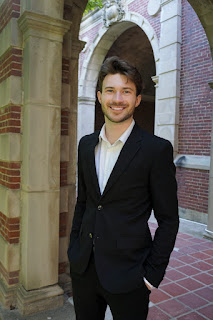Incoming MA Student Presents on Nabokov, Dr. Jekyll, and Mr. Hyde
Incoming MA student Adam Riekstins recently presented at a conference hosted by the Hidden Nabokov Society, as part of its first international conference in over two decades. The conference took place from June 15th to June 19th at Wellesley college, where Vladimir Nabokov once lectured.
According to Riekstins, "It was such a humbling experience to chat, dine and interact with Nabokov experts from everywhere around the world for nearly a week straight. It was, as most of us joked, a beguiling Nabokovian Summer Camp." Riekstins presented on Lolita as a gothic novel, tracing structural similarities it shares with Robert Louis Stevenson's The Strange Case of Dr. Jekyll and Mr. Hyde.
As part of the proceedings, presenters even had an opportunity to view Nabokov's personal butterfly collection, which is housed at Harvard's Museum of Comparative Zoology. "Thank you," said Riekstins, "to Wellesley College for hosting the event and to Harvard's Museum of Comparative Zoology entomology department for allowing us to examine Nabokov’s private butterfly collection."
Here is the abstract for Riekstin's presentation on Lolita, titled: The Ugly and Justifiable: Lolita and The Strange Case of Dr. Jekyll and Mr. Hyde.
Though published nearly a century after Robert Louis Stevenson’s The Strange Case of Dr. Jekyll and Mr. Hyde, Vladimir Nabokov’s most critically acclaimed work, Lolita, shares an uncanny resemblance to the Gothic classic. Nabokov revered Dr. Jekyll and Mr. Hyde, considering the book to be “one of the ancestors of the modern mystery story” (Nabokov). Though we may not immediately consider Lolita a “mystery story,” in examining it alongside Jekyll and Hyde, we can see the novel through new eyes. Both Lolita and The Strange Case of Dr. Jekyll and Mr. Hyde share similar structures, protagonist archetypes, nemesis roles and supernatural elements that make clear Stevenson’s large influence on Nabokov. Nabokov adopted the Gothic genre to reinforce a classic warning: the importance of not allowing one’s dark desires to usurp control of one’s life. Using excerpts from Nabokov’s lecture, Gry Faurholt’s “Self as Other: The Doppelganger” and the novels themselves, I will compare the Gothic elements utilized by Stevenson and Nabokov in order to show how Lolita is, in fact, a piece of Gothic literature. Seeing Nabokov’s novel as a Gothic work helps to more closely identify and determine the originally intended messages in the story, unlocking new meaning behind each plot beat, character, setting and so on. Lolita aims to make readers empathize with pedophilia, rape and murder, and it is only with the application of Gothic theory we realize how this goal is accomplished so effectively. Without Stevenson, Nabokov would not have had the blueprint to construct what many people consider to be his greatest work, Lolita.
 |
| Adam Riekstins, MA '24 |
Comments
Post a Comment